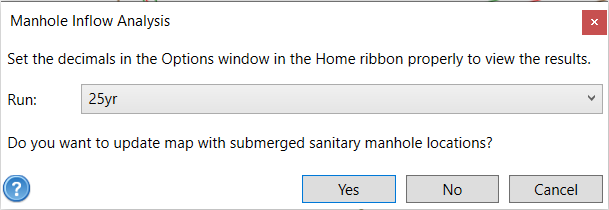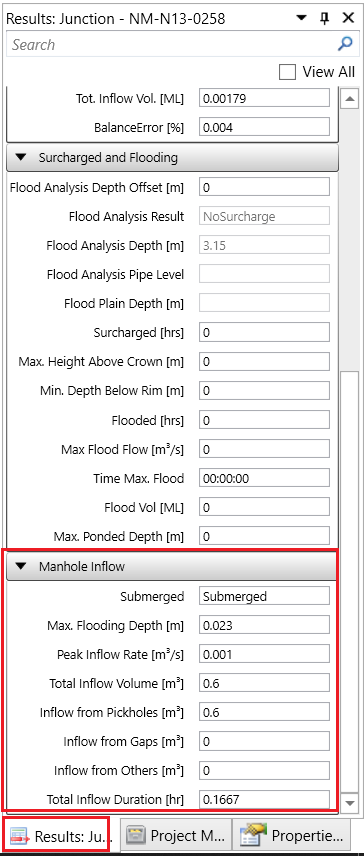Click the Manhole Inflow Analysis button to open the tool window. Choose the desired Run in the drop-down list. Click Yes if users want to update the map automatically with the analysis index Submerged after the analysis is done. Please refer below about the meaning of Submerged in the analysis indices. Click No, if users just want to run the analysis.

This tool, no matter choosing to update map or not, will calculate the following indices at each manhole based on the simulation results: the manhole Submerged or not, Max Flooding Depth, Peak Inflow Rate, Total Inflow Volume, Inflow from Pickholes, Inflow from Gaps, Inflow from Others, and Total Inflow Duration.
The manhole inflow analysis results will be summarized into the Junction tab in the Result Summary Tables and also in the Results tab.


- Submerged: this field has three categories and their meanings are explained as:
- Submerged – this manhole is submerged at any time during the modelled period
- Not Submerged – this manhole is not submerged at any time during the modelled period
- NA – this manhole does not have an outlet link used for manhole inflow modeling.
- If users choose to update the map automatically with the Submerged analysis index, the manholes Submerged will be displayed with red dots, the manholes Not Submerged will be displayed as black dots, and the rest manholes will be displayed as NA. The links will be displayed as black lines. The map will only show the system that has manholes defined. For example, if the model only defines the manholes in sanitary system, the map will only display the sanitary system.
- Max Flooding Depth: the max submerged depth of the manhole. In other word, the max overland flow depth substracts its connected manhole’s top elevation. The calculation precision of the Max Flooding Depth has 3 decimals and its displaying decimal in the Summary Results Table is controlled by the the decimal of Node Depth (Home -> Options -> Result Display Decimals -> Node -> Depth). It is recommended to have at least 3 decimals to view the results properly.
- Peak Inflow Rate: the max manhole inflow and infiltration flow rate. The calculation precision of the Peak Inflow Rate has 6 decimals and its displaying decimal in the Summary Results Table is controlled by the the decimal of Link Flow (Home -> Options -> Result Display Decimals -> Link -> Flow). It is recommended to have at least 4 decimals to view the results properly.
- Total Inflow Volume: the total water volume entering the sewer via the manhole. The analysis will breakdown the total volume into three sources based on the user’s defined inflow sources. The calculation precision of the Total Inflow Volume has 6 decimals and its displaying decimal in the Summary Results Table is controlled by the the decimal of Link Volume (Home -> Options -> Result Display Decimals -> Link -> Volume). It is recommended to have at least 2 decimals to view the results properly.
- Inflow from Pickholes: the volume of manhole inflow contributed from manhole pickholes. This part of water volume is defined by the Inflow Source – Manhole Lid Pickholes. The decimal settings are the same as Total Inflow Volume.
- Inflow from Gaps: the volume of manhole inflow contributed from manhole gaps. This part of water volume is defined by the Inflow Source – Manhole Lid/Frame Gaps. The decimal settings are the same as Total Inflow Volume.
- Inflow from Other: the volume of manhole inflow contributed from other sources. This part of water volume is defined by the Inflow Source – Other. The decimal settings are the same as Total Inflow Volume.
- Total Inflow Duration: the total hours when there is inflow and infiltration occurring at that manhole. The calculation precision of the Total Inflow Duration is 4.
In the Properties tab of Manhole junctions, if no Rating Curve Sources are selected or assigned, in other words, on the Properties tab, Rating Curve Sources shows NO, the Manhole Inflow Analysis tool will assume all the Total Inflow Volume comes from Pickholes
For more information, please refer to the explanation on Manhole Inflow and Infiltration Modeling and the tutorial Modeling and Analysis of Manhole Inflow & Infiltration Using Dual-Drainage Method



